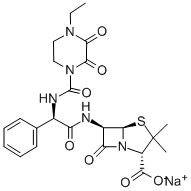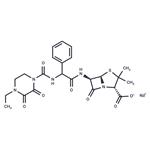Description
Piperacillin sodium is a new beta-lactam antibiotic developed in 1977 by Ueo et al. at Toyama Chemical Company Ltd of Japan. It is licensed and marketed by Lederle Laboratories as Pipracil in the United States. The chemical name of piperacillin sodium is sodium [2S-[2α, 5α, 6β(S*)]]-6-[[[[(4-ethyl-2,3-dioxo1 -piperazinyl) carbonyll-amino] phenylacetyl] amino] -3,3-dimethyl-7-oxo-4-thia- 1 -azabicyclo[3.2.0]heptane-2-carboxylate. It was originally referred to as T1220. Piperacillin is an acylampicillin derivative and is similar in many respects to the previously marketed carboxypenicillins carbenicillin and ticarcillin, the two new ureidopenicillins mezlocillin and azlocillin, and the third-generation cephalosporin (-like) agents cefotaxime, moxalactam, and cefoperazone (the latter is not yet marketed and is structurally similar to piperacillin)[1].
Chemical Properties
When reconstituted, piperacillin sodium is a white to off-white hydroscopic cryodesiccated crystalline that gives a colorless to pale yellow solution. The empirical formula is C23H26N5NaO7S (1.85 mEq or 42.55 mg sodium per gram). One gram of piperacillin is soluble in 1.4 ml of water at 23°C, and the pH of the aqueous solution is 5.5-7.0.
Indications
Piperacillin has been approved for patients with severe infection caused by susceptible strains of specific organisms in the intra-abdominal, urinary tract, gynecologic, lower respiratory tract, skin and skin structure, bone and joint, gonococcal infections, and septicemia. As with other penicillins, piperacillin has a low frequency of toxicity.
benefits
Piperacillin sodium is a beta-lactam antibiotic with a broad range of antibacterial activity that includes gram-negative bacilli, gram-positive cocci (except penicillinase-producing S. aureus), and anaerobic pathogens such as Clostridium difficile, and Bacteroides fragilis. Piperacillin inhibits many of the members of the Enterobacteriaceae, including Klebsiella sp and Pseudomonas, at lower concentrations than required for carbenicillin and ticarcillin.
Metabolism
Piperacillin sodium is administered by intramuscular and intravenous injection and is widely distributed throughout body fluids and tissues. Like other newer penicillins, piperacillin is excreted by both renal and biliary mechanisms. The primary route of elimination is by glomerular filtration, which results in high urinary concentrations of the unchanged compound.
References
[1] C L Fortner, S C Schimpff, R S Finley. “Piperacillin sodium: antibacterial spectrum, pharmacokinetics, clinical efficacy, and adverse reactions.” Pharmacotherapy 2 6 (1982): 287–99.




